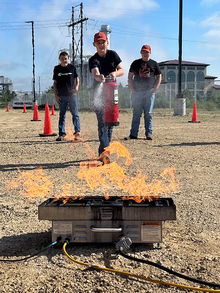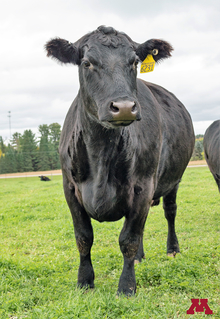According to the Minnesota Department of Agriculture, a farmer is 800% more likely to die while working than people in other jobs. About one-third of all farm accidents involve children.
Hazards include tractor rollovers, grain bins, manure pits, fire, toxic gases and more. Training and using safety equipment are two top ways to reduce the danger.
Emily Krekelberg, University of Minnesota Extension educator, delivered farm safety education to nearly 1,000 people in 2022 and has plans to grow her work with 4-H youth who live on farms or visit farms, as well as with immigrants and others who are new to farming in the U.S.
Krekelberg knows all too well the dangers of farm work. Her father lost a leg at age 19 and her brother lost an arm at age 16. Listen to the story on Extension’s The Moos Room podcast, episode 84. The Moos Room podcast has several more episodes focused on safety.
“When I deliver farm safety programs to youth and adults, my family’s story gets their attention right away,” she says. “And then I can focus on education that can save someone’s life or limb.”
Handling livestock with care — and caution
Everyone involved in animal production needs to take livestock handling seriously.
Dr. Joe Armstrong, Extension cattle production systems educator, says many of the concepts he teaches can apply to other animals besides cattle. They apply to everyone from farm youth to experienced operators, workers, transporters and veterinarians.
“I don’t really care how strong you think you are — that cow is stronger every time,” Armstrong tells viewers in a livestock safety webinar. “Some of our bigger pigs are incredibly strong, even some of our sheep and goats.”
Livestock animals do not usually want to hurt people, but they may have heightened responses to fear and being alone because they are prey animals. For the same reason, they may also become overly protective in certain situations — a cow after giving birth, for example. Bulls can be aggressive and powerful, so Armstrong and his team have specific resources for those who must handle them.
“Understanding animals and their behavior teaches livestock handlers why safety measures are in place,” says Armstrong. “I talk about livestock handling at almost every educational event because it is that important for human safety and for the health of the animals.”
See the webinar and visit the Farm Safety YouTube channel.
Safe practices for the farm
Child safety on the farm
Farm safety training for young people makes a big difference, but caregivers are ultimately responsible for keeping them safe.
Supervise children while playing or working on the farm
More than half of child injuries on farms happen to children who are not working but are simply in the vicinity of dangerous activities.
Warn children about on-farm hazards
Don’t assume that hazards are obvious. Talk to kids about what makes certain areas of the farm dangerous and ask them what they think they can do to keep themselves safe.
Give children age-appropriate tasks
Think about age, development and body size. Check the Agricultural Youth Work Guidelines from the National Children’s Center for Rural and Agricultural Health and Safety.
Permission is granted to news media to republish our news articles with credit to University of Minnesota Extension. Images also may be republished; please check for specific photographer credits or limited use restrictions in the photo title.




